University of Leicester
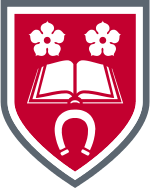 | ||||||||||||
| Motto |
Ut Vitam Habeant So that they may have life | |||||||||||
|---|---|---|---|---|---|---|---|---|---|---|---|---|
| Type | Public | |||||||||||
| Established |
1957 - gained University Status by Royal Charter 1921 - Leicestershire and Rutland University College | |||||||||||
| Endowment | £13.1 million (2015)[1] | |||||||||||
| Chancellor | Lord Grocott | |||||||||||
| Vice-Chancellor | Paul Boyle[2] | |||||||||||
| Visitor | The Queen[3] | |||||||||||
Academic staff | 2,030[4] | |||||||||||
Administrative staff | 2,495[4] | |||||||||||
| Students | 17,995 (2014/15)[5] | |||||||||||
| Undergraduates | 11,030 (2014/15)[5] | |||||||||||
| Postgraduates | 6,965 (2014/15)[5] | |||||||||||
| Location | Leicester, England, UK | |||||||||||
| Campus | Urban parkland | |||||||||||
| Colours |
| |||||||||||
| Affiliations |
AMBA EUA ACU EMUA M5 Universities | |||||||||||
| Website |
www | |||||||||||
 | ||||||||||||
The University of Leicester (![]() i/ˈlɛstə/ LES-tər) is a public research university based in Leicester, England. The main campus is south of the city centre, adjacent to Victoria Park.
i/ˈlɛstə/ LES-tər) is a public research university based in Leicester, England. The main campus is south of the city centre, adjacent to Victoria Park.
The university established itself as a research-led university and was a member of the 1994 Group, previously ranking among the top 20 universities in the United Kingdom.[6] The university is currently ranked 47th among 126 UK universities.[7]
The university is most famous for the invention of genetic fingerprinting and contributing to the discovery and identification of the remains of King Richard III.[8]
History
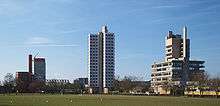
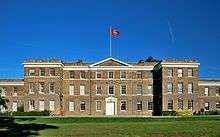
The university was founded as Leicestershire and Rutland University College in 1921. The site for the university was donated by a local textile manufacturer, Thomas Fielding Johnson, in order to create a living memorial for those who lost their lives in First World War. This is reflected in the University's motto Ut Vitam Habeant –"so that they may have life".
Students were first admitted to the college in 1921. In 1927, after it became University College, Leicester, students sat the examinations for external degrees of the University of London. Two years later it merged with the Vaughan Working Men's College, which had been providing adult education in Leicester since 1862.[9] In 1957 the University College was granted its Royal Charter, and has since then had the status of a university with the right to award its own degrees. Leicester University won the first ever series of University Challenge, in 1963.
Campus
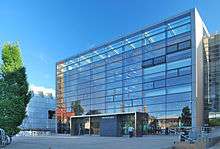
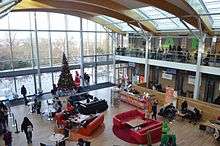
The main campus is a mile south of the city centre, adjacent to Victoria Park and Wyggeston and Queen Elizabeth I College.
The central building, now known as the Fielding Johnson Building and housing the University's administration offices and Faculty of Law, dates from 1837 and was formerly the Leicestershire and Rutland Lunatic Asylum. Opposite the Fielding Johnson Building are the Astley Clarke Building, home to the School of Economics, and the University Sports Centre.
The Ken Edwards building, built in 1995, lies adjacent to the Fielding Johnson Building and is home to the School of Management.
Built in 1957, the Percy Gee building is home to Leicester University's Students' Union.
The David Wilson Library was opened by Queen Elizabeth II on 4 December 2008, following an extensive refurbishment with a budget of £32 million.[10]
The university campus is home to several notable examples of Brutalist architecture, including the Grade II listed Engineering Building and the Charles Wilson Building. Another prominent building on campus is the 18-storey Attenborough Tower, home to the College of Social Sciences.
The Bennett building, Physics and Astronomy building, the Chemistry building and the Adrian Building lie beyond the Charles Wilson Building. Across University Road lies the Maurice Shock and Hodgkin buildings, home to Leicester's Medical School.
Further along University Road and on Salisbury Road and Regents Road are the Department of Education and the Fraser Noble building.
Notable architecture
The skyline of Leicester University is punctuated by three distinctive, towering, buildings from the 1960s: the Department of Engineering, the Attenborough tower and the Charles Wilson building.
The University's Engineering Building was the first major building by British architect James Stirling. It comprises workshops and laboratories at ground level, and a tower containing offices and lecture theatres. It was completed in 1963 and is notable for the way in which its external form reflects its internal functions. The very compact campus contains a wide range of twentieth century architecture, though the oldest building is the Fielding Johnson building. The Attenborough Tower is undergoing extensive renovation.
Leicester's halls of residence are noteworthy: many of the halls (nearly all located in Oadby) date from the early 1900s and were the homes of Leicester’s wealthy industrialists.
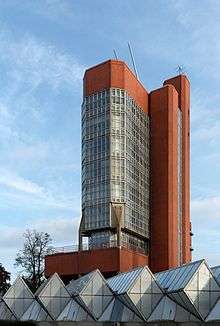
 The Physics and Astronomy building, part of a larger complex by Leslie Martin
The Physics and Astronomy building, part of a larger complex by Leslie Martin The brutalist Charles Wilson Building by Denys Lasdun
The brutalist Charles Wilson Building by Denys Lasdun Eye of Time sundial
Eye of Time sundial Vaughan College, the university's former adult education college, is Grade II listed and faces the Jewry Wall Roman ruins
Vaughan College, the university's former adult education college, is Grade II listed and faces the Jewry Wall Roman ruins
Development
In recent years the University has disposed of some of its poorer quality property in order to invest in new facilities, and is currently undergoing a £300+ million redevelopment. The new John Foster Hall of Residence opened in October 2006. The David Wilson Library, twice the size of the previous University Library, opened on 1 April 2008 and a new biomedical research building (the Henry Wellcome Building) has already been constructed. A complete revamp of the Percy Gee Student Union building (originally opened by Queen Elizabeth II on 9 May 1958[11]) was completed in September 2010. Nixon Court was extended and refurbished in 2011.
Organisation
The University's academic schools and departments, having been previously organised into five faculties, were re-organised into four colleges in 2009, each headed by a Pro-Vice Chancellor[12] In August 2015 the colleges were further restructured[13] with the merging of Social Sciences and Arts, Humanities and Law to give the following structure:[14]
- College of Social Sciences, Arts and Humanities
- College of Medicine, Biological Sciences and Psychology
- College of Science & Engineering
The colleges are supported by the Corporate Services.
Academic profile
Teaching
The University is held in high regard for the quality of its teaching.[15] 19 subject areas have been graded as "Excellent" by the Quality Assurance Agency – including 14 successive scores of 22 points or above stretching back to 1998, six of which were maximum scores.
Leicester was ranked joint first in the 2005, 2006 and 2007 National Student Survey for overall student satisfaction among mainstream universities in England. It was second only to Cambridge in 2008 and again joint first in 2009.[16]
Science
The University has research groups in the areas of astrophysics, biochemistry and genetics. The techniques used in genetic fingerprinting were invented and developed at Leicester in 1984 by Sir Alec Jeffreys. It also houses Europe's biggest academic centre for space research , in which space probes have been built, most notably the Mars Lander Beagle 2, which was built in collaboration with the Open University.
Leicester Physicists (led by Ken Pounds) were critical in demonstrating a fundamental prediction of Einstein's General Theory of Relativity - that black holes exist and are common in the universe. It is a founding partner of the £52 million National Space Centre.
Leicester University is one of a small number of universities to have won the prestigious Queen's Anniversary Prize for Higher Education on more than one occasion: in 1994 for physics & astronomy and again in 2002 for genetics.
Physics and Astronomy
The Department is host to around 350 undergraduate students, following either BSc (three-year) or MPhys (four-year) degree courses, and over 70 postgraduate students registered for a higher degree.[17]
The main Physics building accommodates several research groups—Radio and Space Plasma Physics (RSPP), X-ray and Observational Astronomy (XROA), Condensed Matter Physics (CMP) and Theoretical Astrophysics (TA)—as well as centres for supercomputing, microscopy, Gamma and X-ray astronomy, and radar sounding, and the Swift UK Data Centre. A purpose built Space Research Centre houses the Space Science and Instrumentation (SSI) group and provides laboratories, clean rooms and other facilities for instrumentation research, Earth Observation Science (EOS) and the Bio-imaging Unit. The department also runs the University of Leicester Observatory in Manor Road, Oadby, with a 20-inch telescope it is one of the UK's largest and most advanced astronomical teaching facilities.[18] The department has close involvement with the National Space Centre also located in Leicester.
The department is home to the University's ALICE 3400+ core supercomputer[19] and is a member of the UK's DiRAC (DiStributed Research utilising Advanced Computing) consortium. DiRAC is the integrated supercomputing facility for theoretical modelling and HPC-based research in particle physics, astronomy and cosmology, areas in which the UK is world-leading. It was funded as a result of investment of £12.32 million, from the Government's Large Facilities Capital Fund, together with investment from the Science and Technology Facilities Council and from universities.[20]
The department is a member of the Pi-CETL collaboration of three university physics departments with a track record in teaching and learning innovation. The Physics Innovations CETL is one of 74 Centres for Excellence in Teaching and Learning, over all academic disciplines, and the only one in physics. It was funded for five years (2005–10) by the Higher Education Funding Council for England's (HEFCE). Pi-CETL involved collaboration between the Open University and the Universities of Leicester and Reading.
In 1994 the University of Leicester celebrated winning the Queen's Anniversary Prize for its work in Physics & Astronomy. The prize citation reads: "World-class teaching, research and consultancy programme in astronomy and space and planetary science fields. Practical results from advanced thinking".[21]
Engineering

The department offers MEng and BEng degrees in Aerospace Engineering, Embedded Systems Engineering, Communications and Electronic Engineering, Electrical and Electronic Engineering, Mechanical Engineering and General Engineering. Each course is accredited by the relevant professional institutions. The department also offers MSc courses in Embedded Systems and Control, Information and Communication Engineering, Advanced Mechanical Engineering, and Advanced Electrical and Electronic Engineering.
The department has an extensive range of industrial partners including: ARM Holdings, BAE Systems, Rolls-Royce, Jaguar, Siemens, Corus, Mercedes-Benz. Many undergraduate and postgraduate projects are carried out in collaboration with industry.
Arts, humanities and social sciences
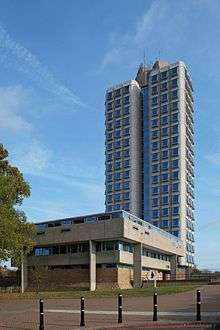
More recently, novelist Adele Parks graduated from the university in the 1990s, and the university library now holds the writings of both Joe Orton and Sue Townsend.
College of Arts, Humanities & Law
The School of Archaeology and Ancient History was formed in 1990 from the then Departments of Archaeology and Classics, under the headship of Graeme Barker, FBA. It was headed from 2006 to 2012 by Colin Haselgrove, and the current head is Lin Foxhall, Hon. MBE. The academic staff currently (as of July 2012) includes 21 archaeologists and 6 ancient historians, though several staff teach and research in both disciplines; seven staff hold the rank of Professor.
In the 2008 Research Assessment Exercise, 65% of its research was placed in the top two classes of excellence (4* and 3*),[22] making it second equal among UK archaeology departments and first equal among departments teaching both archaeology and ancient history.
The School has particular strengths in Mediterranean archaeology, ancient Greek and Roman history, and the archaeology of recent periods; and is also home to the University of Leicester Archaeological Services (ULAS).[23] In April 2008, the Centre for Historical Archaeology was opened. The Leverhulme-funded "Tracing Networks" project is based in the School.[24]
In September 2012, the University of Leicester exhumed the body of King Richard III, discovering it in the former Greyfriars Friary Church in the city of Leicester, England. The university announced on 4 February 2013 that the body had correctly been identified, and was Richard's body "beyond all reasonable doubt".[25]
The School of English teaches English at degree level. The School is committed to offering the whole spectrum of English Studies from Contemporary Writing to Old English and language studies. It contains the distinguished Victorian Studies Centre, the first of its kind in the UK.
Malcolm Bradbury is one of the Department's most famous alumni: he graduated with a First in English in 1953.
The School of Historical Studies is, with 35 full-time members of staff, including 11 Professors as of 2009, one of the largest of any university in the country. It has made considerable scholarly achievements in many areas of history, notably Urban History, English Local History, American Studies and Holocaust Studies.[26] The School houses both the East Midlands Oral History Archive (EMOHA)[27] and the Media Archive for Central England (MACE).[28]
The School of Law is one of the biggest departments in the University. The Faculty maintains links with many top law firms, including the Magic Circle firm Freshfields Bruckhaus Deringer, who offer a one-year scholarship to a Leicester student studying for the dual Law and French degree. According to the Times Online Good University Guide 2009, the Faculty of Law was ranked 8th, out of 87 institutions, making it one of the top law schools in the country.
The School of Museum Studies has the highest proportion of world-leading rated research in any subject in any UK university (RAE 2008).[29] In its 40-year history the school has played an influential role in the reinvention of museum theory and practice.
The School of Geography and Geology, housed in the Bennett building, is notable for its collection of maps dating back almost a century, and equally for the Geology department's fossil collection. Both departments feature highly in rankings for the UK.
Also within the College of Arts, Humanities, and Law are the Department for the History of Art and Film and the School of Modern Languages.
Mass Communication Research
Within the College of Social Sciences, the Centre for Mass Communication Research, now part of the Department of Media and Communications, is one of the longest established academic centres at Leicester, engaging in pioneering research in the 1970s and 1980s and now specializing in Masters courses, as does the Department of Museum Studies, in terms of both campus-based and distance-learning Masters.
School of Business
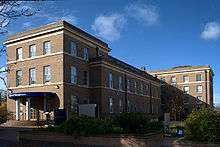
Within the College of Social Science, the School of Business is dedicated to the advanced study and teaching of the subject matter of Management and Economics.The "School of Business" was founded in 2016, bringing together the expertise of the School of Management and the Department of Economics. The new school now has approximately 150 academic staff, 50 from Economics and 100 from Management. The Dean of the School of Business, Professor Zoe Radnor, arrived from the University of Loughborough in 2016. In 2010 the former School of Management was ranked 2nd after Oxford University by the Guardian.[30]
The School encourages the development of innovation and creativity through dialog, criticism and integrative learning. Professor Gibson Burrell's attempt to develop a critical management school at the University of Leicester, has been recognized in the academic literature.[31]
The School of Business provides postgraduate and undergraduate programmes in Management, Accounting and Economics. The School of Business, is one of the only 168 Schools/Universities in the world accredited by the Association of MBAs.[32]
Learning Innovation and Technology-Enhanced Learning
The Institute of Learning Innovation within the University of Leicester is a research and postgraduate teaching group, directed by Grainne Conole. The Institute has and continues to research on UK- and European-funded projects (over 30 as of August 2013),[33] focusing on topics such as educational use of podcasting,[34] e-readers in distance education,[35] virtual worlds, open educational resources and open education,[36] and learning design.[37]
Leicester Medical School
The university is home to a large medical school, Leicester Medical School, which opened in 1971. The school was formerly in partnership with the University of Warwick, and the Leicester-Warwick medical school proved to be a success in helping Leicester expand, and Warwick establish. The partnership ran the end of its course towards the end of 2006 and the medical schools became autonomous institutions within their respective universities.
Rankings and reputation
| ARWU[38] (2016, national) | 22-28 | |
|---|---|---|
| ARWU[39] (2016, world) | 201-300 | |
| QS[40] (2016/17, national) | 33 | |
| QS[41] (2016/17, world) | 239 | |
| THE[42] (2016/17, national) | 26 | |
| THE[43] (2016/17, world) | 172 | |
| Complete[44] (2017, national) |
32 | |
| The Guardian[45] (2017, national) |
47 | |
| Times/Sunday Times[46] (2017, national) |
25 | |
The university established itself as a research-led university and was named University of the Year of 2008 by the Times Higher Education.[47] It is also the only university ever to have won a Times Higher Education award in seven consecutive years. The university previously ranked among the top 20 universities in the United Kingdom by the Times Good University Guide and The Guardian.[6] Since 2014, the university has continued to fall below that level across all rankings, which it has defined as 'disappointing'.[48] In 2016, the university ranked 24th in the The Complete University Guide and 32nd in the The Guardian; it now ranks 47th among 126 universities.[49]
Library special collections
Local history collections (for the Centre for English Local History), known as the Marc Fitch Library, including:
- Thomas Hatton (1876–1943), a local businessman whose collection of nearly 2,000 books on English local history was donated to the Library of Leicester College in 1920. This was one of the first major donations to the Library.[50]
The library also holds a number of collections containing items written by several famous writers, these include:
- The Joe Orton Collection. Joe Orton (1933–1967) was a Leicester-born playwright, the collection contains his manuscripts and correspondence.
- The Laura Riding Letters. The collected correspondence of the American poet and critic Laura Riding (1901–1991).
- The Sue Townsend Collection. The personal papers of Sue Townsend (1946-2014). The collection contains Townsend's literary correspondence and notebooks detailing her works.
- Archives of the Institute for the Study of Terrorism.
Student life
The university has a number of different societies within its students' union. The Union has around 200 different societies.[51]
Student media
Founded in 1957, The Ripple is the university's student magazine.
Founded in 1996, LUSH Radio is the radio station of the University of Leicester Students' Union. It is run and presented exclusively by students and broadcasts a mixture of music, chat and news.[52] Some notable personalities from the early days of LUSH Radio (or LUSH FM as it was known at the time) who have gone on to work in the media are Lucy O'Doherty (BBC 6 Music) and Adam Mitchenall (ETV).
Annual events
The station holds an annual 24-hour charity broadcast. In 2011, £300 was raised for Comic Relief. In 2013 the station held its first '69 Hour Broadcast', which raised over £450 for Comic Relief.[53]
The station holds an award ceremony every year, the "LUSH Awards". This aims to recognise the achievements and successes of the station's broadcasters and producers.
LUSH have broadcast live the annual Varsity match against De Montfort University for both Football from the King Power Stadium and Rugby Union from Welford Road Stadium.
LUST
LUST (Leicester University Student Television) was re-founded in 2002 after a period of dormancy. The station is affiliated to the National Student Television Association (NaSTA) and hosted the association's annual awards ceremony in 2008.
Notable people
Chancellors
- Edgar Adrian, 1st Baron Adrian (1957–1971)
- Alan Lloyd Hodgkin (1971–1984)
- Sir George Porter (1984–1995)
- Sir Michael Atiyah (1995–2005)
- Sir Peter Williams (2005–2010)[54]
- Bruce Grocott, Baron Grocott (2013–)
Notable academics
- Khurshid Ahmad, Islamic scholar
- Lyman Andrews, American Studies
- Isobel Armstrong, scholar of nineteenth-century poetry and women's writing
- Graeme Barker, Disney Professor of Archaeology, University of Cambridge
- Richard Bonney, historian
- Alan Bryman, social scientist
- Grace Burrows, violinist and orchestra conductor
- Neil Christie, Reader in Archaeology
- John Coffey, Professor of Early Modern history.
- Heather Couper, astronomer and television presenter
- Nicholas J. Cull, US historian
- Panicos Demetriades, economist and Governor of the Central Bank of Cyprus
- Gabriel Dover, geneticist
- Eric Dunning, sports sociologist
- Christopher Dyer, medieval historian
- Colin Eaborn FRS, chemist
- Norbert Elias, German sociologist
- Brian J. Ford, scientist, visiting professor
- G. S. Fraser, Scottish poet
- Anthony Giddens, prominent sociologist, taught social psychology at Leicester
- Reuben Goodstein, mathematician, proponent of Goodstein's theorem
- Cosmo Graham, Public law and Competition law specialist. Member of the Competition Commission
- Sarah Hainsworth, Professor of Materials and Forensic Engineering, involved in analysing the wounds on the skeleton of Richard III
- Jeffrey A. Hoffman, NASA astronaut and physicist
- Richard Hoggart, sociologist
- W. G. Hoskins, (1931–1952) (1965–1968), local historian, author of The Making of the English Landscape
- Norman Housley, crusading historian
- Arthur Humphreys, inaugural Professor of English and first Dean of the Faculty of Arts
- Leonard Huxley, physicist
- Sir Alec Jeffreys, geneticist, inventor of genetic fingerprinting
- Hans Kornberg, biochemist
- Philip Larkin, librarian and poet
- David Mattingly, Roman archaeologist
- John McManners, former Head of History Dept., Regius Professor of History at the University of Oxford until retirement
- Ken Pounds, Emeritus Professor of Physics, discovered black holes were common in the universe
- Charles Rees, organic chemist
- Lord Rees of Ludlow, the Astronomer Royal, visiting professor at Leicester
- J.B. Schneewind, philosophy professor, Johns Hopkins University
- Malcolm Shaw QC, The Sir Robert Jennings Professor of International Law, prominent international lawyer and jurist
- Jack Simmons, professor of history 1947–1975
- Brian Simon, professor of education 1966-1980
- Sami Zubaida, political scientist
Notable alumni
See also Alumni of the University of Leicester.
Numerous public figures in many diverse fields have been students at the University, including:
- Peter Atkins, physical chemist
- Natalie Bennett, Leader of the Green Party of England and Wales[55]
- David Blanchflower, economist, Dartmouth College professor
- Sir Malcolm Bradbury, author
- Justin Chadwick, actor and director
- Philip Campbell, editor-in-chief of Nature
- Michael Cordy, novelist
- Liam Donaldson, Chief Medical Officer
- Lord Grocott, former MP, Captain of the Gentlemen-at-Arms
- Phelan Hill, Team GB coxswain and Olympic bronze medalist
- Baroness Howarth of Breckland, peer, on the board of CAFCASS
- Atifete Jahjaga, President of Kosovo
- Graham Joyce, novelist
- Jyrki Katainen, Prime Minister of Finland [56]
- Norman Lamb, MP
- Martin Löb, Logician and proposer of Löb's theorem
- Her Imperial Highness Princess Mako of Akishino
- Pete McCarthy, writer, broadcaster, comedian
- Sunshine Martyn, Reality television star
- Bob Mortimer, comedian
- Massimiliano Neri, fashion model
- Michael Nicholson, journalist
- Bob Parr MBE, multi Emmy Award-winning television producer and former Special Air Service soldier
- J. H. Plumb, historian of 18th-century Britain
- Aaron Porter, President, National Union of Students (United Kingdom) 2010-11
- Patrick Redmond, novelist
- C. P. Snow, author
- Mary Ann Steggles, Commonwealth Scholar from Canada, international expert on British sculpture exported to the Indian subcontinent and Southeast Asia
- Sir John Stevens, former Metropolitan Police Commissioner and former adviser on international security issues to Gordon Brown
- John Sutherland, Guardian Columnist, Emeritus Professor of English Literature, University College London
- Laurie Taylor, broadcaster, actor, sociologist
- Philip Tew, professor of English (Post-1900 Literature), Brunel University
- Steven Thiru, current president of Malaysian Bar
- Jon Tickle, celebrity
- Storm Thorgerson, artist
- Tony Underwood, England rugby union international
- Sir Alan Walters, economist and former Chief Economic Adviser to Margaret Thatcher, 1981–83 and 1989.
- Andrew Waterman, poet
- Quentin Willson, motoring journalist/expert and TV presenter
- Bryan R. Wilson, Oxford sociologist
- Ted Wragg, educationalist
- Malik Zahoor Ahmad, Pakistan Minister of Information
The Attenboroughs
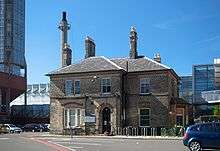
The University of Leicester is commonly associated with the Attenborough family. Richard and David Attenborough (with their younger brother John) spent their childhood in College House, which is now home to part of the Maths department (and is now near to the Attenborough tower, the tallest building on the campus and home to many of the arts and humanities departments). Their father Frederick Attenborough was Principal of the University College from 1932 until 1951. The brothers were educated at the adjacent grammar school before attending the Royal Academy of Dramatic Art and the University of Cambridge respectively.
Both have maintained links with the university—David Attenborough was made an honorary Doctor of Letters in 1970 and opened the Attenborough Arboretum in Knighton in 1997. In the same year, the Richard Attenborough Centre for Disability and the Arts was opened by Diana, Princess of Wales. Both brothers were made Distinguished Honorary Fellows of the University at the degree ceremony in the afternoon of 13 July 2006.
See also
- National Space Centre
- Peer English, an academic journal published by the Department of English
- Stanley Burton Centre for Holocaust Studies
- University of Leicester Botanic Garden
References
- ↑ http://www2.le.ac.uk/offices/finance/documents/Fin%20Statements/financial-statements-2014-15
- ↑ "University welcomes new President and Vice-Chancellor". University of Leicester. Retrieved 2014-10-08.
- ↑ "University of Leicester Calendar".
- 1 2 "Profile 2009" (pdf). University of Leicester. Retrieved 2013-02-27.
- 1 2 3 "2014/15 Students by HE provider, level, mode and domicile" (XLSX). Higher Education Statistics Agency. Retrieved 19 January 2016.
- 1 2 "Financial statements 2010/11" (pdf). University of Leicester.
- ↑ "Top UK University League Tables and Rankings 2016". Retrieved 29 June 2015.
- ↑ "Richard III Society pays tribute to exemplary archaeological research". University of Leicester. 15 October 2012. Retrieved 12 February 2013.
- ↑ Brown, Cynthia (2012). A Blessing to the Town: 150 Years of Vaughan College, Leicester. University of Leicester. p. 42. ISBN 9780901507723.
- ↑ "Key Facts and Figures - University of Leicester". University of Leicester. Retrieved 22 September 2014.
- ↑ BBC: How Royal visits have changed http://www.bbc.co.uk/news/uk-england-leicestershire-17300813
- ↑ "University of Leicester - Leicester strengthens management team and announces new academic structure". Retrieved 29 June 2015.
- ↑ "University of Leicester: College structure". University of leicester. Retrieved 12 September 2016.
- ↑ "Pro-Vice-Chancellors and Heads of College". University of Leicester. Retrieved 12 September 2016.
- ↑ QAA.ac.uk
- ↑ "Undergraduate Courses". Retrieved 29 June 2015.
- ↑ , Frequently asked questions. Retrieved 22 March 2015
- ↑ , The University's new observatory is opened. Retrieved 5 March 2012.
- ↑ , ALICE Architecture. Retrieved 22 March 2015
- ↑ , Multi-million pound new national supercomputer to perform astronomical feats. Retrieved 22 March 2015.
- ↑ "The Prizes". Retrieved 29 June 2015.
- ↑ "RAE 2008 : Quality profiles". Retrieved 29 June 2015.
- ↑ "ULAS Archaeology Unit - University of Leicester Archaeological Services. Archaeologists in Leicester, Leicestershire, East Midlands and nationally". Retrieved 29 June 2015.
- ↑ "Tracing Networks". Retrieved 29 June 2015.
- ↑ "Video: Richard III: remains found in Leicester are 'beyond reasonable doubt' those of former king - Telegraph". Telegraph.co.uk. 4 February 2013. Retrieved 29 June 2015.
- ↑ "History at Leicester". Retrieved 29 June 2015.
- ↑ "East Midlands Oral History Archive". Retrieved 29 June 2015.
- ↑ Macearchive.org.uk
- ↑ http://www.rae.ac.uk/results/outstore/RAEOutcomeFull.pdf
- ↑ Guardian University guide 2010: Business and Management studies. guardian.co.uk Retrieved 16 September 2010.
- ↑ Don Antunes, Howard Thomas (2007). "The Competitive (Dis)Advantages of European Business Schools", Long Range Planning, Volume 40, Issue 3, pp. 382-404.
- ↑ Association of MBAs. mbaworld.com Retrieved 16 September 2010.
- ↑ "Institute of Learning Innovation". Retrieved 29 June 2015.
- ↑ Edirisingha, P., Hawkridge, D., and Fothergill, J. (2010). A Renaissance of Audio: Podcasting approaches for learning on campus and beyond, European Journal of Open Distance and E-Learning.
- ↑ Rogerson-Revell, P., M. Nie & A. Armellini (2012), "An evaluation of the use of voice boards, e-book readers and virtual worlds in a postgraduate distance learning Applied Linguistics and TESOL programme". Open Learning, 27(2), 103-119.
- ↑ Nikoi, S., T. Rowlett, A. Armellini & G. Witthaus (2011). "CORRE: A framework for evaluating and transforming teaching materials into Open Educational Resources". Open Learning, 26(3), 191-207.
- ↑ Conole, G. (2013), Designing for Learning in an Open World, New York: Springer.
- ↑ "Academic Ranking of World Universities 2016 - UK". Shanghai Ranking Consultancy. Retrieved 15 August 2016.
- ↑ "Academic Ranking of World Universities 2016". Shanghai Ranking Consultancy. Retrieved 15 August 2016.
- ↑ "QS World University Rankings 2016/17 - United Kingdom". Quacquarelli Symonds Ltd. Retrieved 7 September 2016.
- ↑ "QS World University Rankings 2016/17". Quacquarelli Symonds Ltd. Retrieved 7 September 2016.
- ↑ "World University Rankings 2016-17 - United Kingdom". Times Higher Education. Retrieved 21 September 2016.
- ↑ "World University Rankings 2016-17". Times Higher Education. Retrieved 21 September 2016.
- ↑ "University League Table 2017". The Complete University Guide. Retrieved 25 April 2016.
- ↑ "University league tables 2017". The Guardian. 23 May 2013. Retrieved 23 May 2016.
- ↑ "The Times and Sunday Times University Good University Guide 2017". Times Newspapers. Retrieved 23 September 2016.
- ↑ "University of Leicester - University of Leicester Named University of the Year". Retrieved 29 June 2015.
- ↑ "Financial statements 2014/15" (pdf). University of Leicester.
- ↑ "Top UK University League Tables and Rankings 2016". Retrieved 29 June 2015.
- ↑ Fyfe, Christine. "What do Laurel and Hardy and 2000 rare books have in common with the University?". University of Leicester. Retrieved 22 February 2015.
- ↑ "Societies". Retrieved 29 June 2015.
- ↑ Radio, LUSH. "About".
- ↑ "Giving Pages Search - Red Nose Day - Red Nose Day". Retrieved 29 June 2015.
- ↑ "University of Leicester elects former student as new Chancellor". University of Leicester. 31 October 2012. Retrieved 3 November 2012.
- ↑ Ferraro, Carmela. "Force of nature". Inside Story. 17 April 2013. Retrieved 27 April 2014.
- ↑ "Finnish PM’s politics formed at the University of Leicester", University of Leicester, 1 May 2013.
External links
| Wikimedia Commons has media related to University of Leicester. |
- University of Leicester website
- Aerial photograph of University College (later Leicester University) in April 1926
Coordinates: 52°37′17″N 1°07′28″W / 52.62139°N 1.12444°W